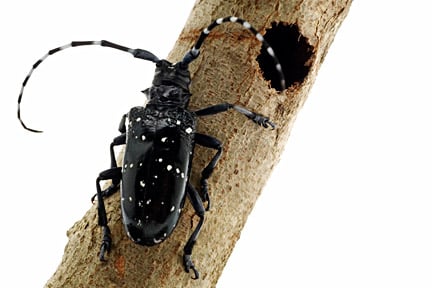
Quick facts
Common names - Citrus longhorn beetle; Asian longhorn beetle
Scientific names - Anoplophora chinensis; A. glabripennis
Plants affected - Acer spp., birch, hazel, citrus, apple and many other deciduous trees and shrubs
Main symptoms - Large (6-11 mm diameter) exit holes in the branches, trunk, stem base and exposed roots
Most active - Adult beetles July-August. Larvae all year round
What are citrus and Asian longhorn beetles?
Asian and citrus longhorn beetles have larvae that feed within the trunks, branches and larger roots of a wide range of trees and shrubs. Whilst most wood boring insects only feed within already dead or dying trees these beetles can affect healthy trees. The tunnels created by the larvae can cause substantial damage. They are native to China, Japan and other parts of south-east Asia. Citrus longhorn beetles have been moved around the world in ornamental trees imported from Asia, especially in Japanese maples from China. The main entry route for Asian longhorn beetle has been in timber used for pallets and wooden packing cases sent with goods imported from east Asia. These beetles pose a serious threat to horticulture, forestry and native trees in Britain.
Citrus longhorn beetles have been intercepted in Britain on imported Japanese maples. An outbreak of Asian longhorn beetle at Paddock Wood, Kent detected in 2012 was declared eradicated in 2019.
Longhorn beetles belong to the beetle family Cerambycidae, there are about 70 species that are found in Britain. None of these native or species is considered a problem as the larvae of most feed on dead or already dying trees. Longhorn beetles can be large and colourful and many are in decline. The native species are an important part of and many help recycle dead wood. Providing this habitat in gardens can help support some of these declining species. Find out more about longhorn beetles at https://www.ukbeetles.co.uk/cerambycidae.
Symptoms
Gardeners may become aware of the presence of these longhorn beetles either when they notice the adult beetle or find exit holes near the base of affected trunks or exposed roots with citrus longhorn, while exit holes of Asian longhorn can be much higher up a tree in the trunk or branches.
- Citrus longhorn beetle is a large (21-37 mm long)black beetle with white markings on its wing cases
- The antennae are particularly distinctive because they are up to twice the length of the body and are black with white/light-blue bands
- The Asian longhorn beetle is very similar in size and appearance
- Some (non-pest) longhorn beetles have banded antennae but they are not black with white spots
- The legless larvae are creamy white with pale brown heads and are up to 56 mm long
The larvae of citrus longhorn beetle make tunnels in the lower trunk and roots of host plants for two years or more. There may be no external signs until the adult beetle emerges, leaving a circular exit hole 6-11mm in diameter. These are typically found near the base of trunks or on exposed roots. Larvae of Asian longhorn beetle develop higher up in the trunks and branches of many trees. The tunnels created by the larval feeding make trees susceptible to disease and wind damage. The adults cause limited damage by eating foliage and young .
The problem
Unlike most wood boring insects citrus and Asian longhorn beetles can kill trees and shrubs.
Asian and citrus longhorn beetle larvae can cause serious damage to healthy trees, both in gardens and in the wider landscape.
Any findings must be reported to the relevant plant health authority or via Tree Alert, contact details can be found on the UK Plant Health Information Portal.
Most native wood boring insects only feed on and within already dead and dying trees. Dead wood is a valuable habitat for many species of and can be a valuable part of a healthy garden ecosystem. More informaton on dead wood in gardens.
Management
If either of these beetles are discovered, the relevant plant health authority will advise what steps must be taken to deal with them. They are difficult to control because the larvae and pupae are concealed and protected within the trunk, branches or larger roots. Currently, the only effective way of controlling larvae is to fell affected trees and destroy them by chipping, burning or deeply burying trunks and roots.
